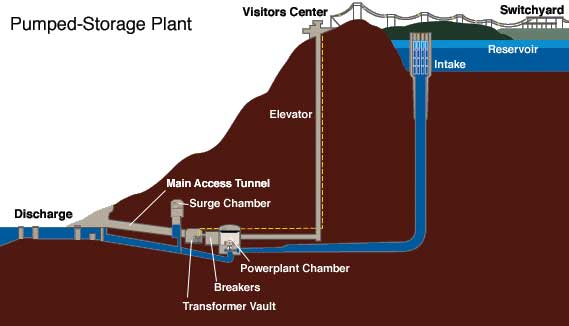Pumped storage
Pumped storage is the process of storing energy by using two vertically separated water reservoirs.[1] Water is pumped from the lower reservoir up into a holding reservoir.[2] Pumped storage facilities store excess energy as gravitational potential energy of water. Since these reservoirs hold such large volumes of water, pumped water storage is considered to be a large scale energy storage system. These pumped storage facilities are moderately efficient, with a round-trip efficiency of about 65-70%.[3] The amount of energy stored depends on the mass of water pumped and the height difference between the reservoirs.
Pumped storage is a dispatchable source of energy since it can be deployed whenever demand is needed. It is often used to meet demand when intermittent, non-dispatchable sources, such as wind and solar power, cannot do so.
Currently pumped storage has the highest capacity of energy storage on the grid and accounts for 99% of bulk storage capacity in the world.[4] The United States alone has more than 20 GW of pumped storage capacity today with facilities in every region of the country.[5]
Over the past 70 years, there has been a steady increase in the number of pumped storage facilities around the world. Some examples of pumped storage facilities worldwide include:[6]
- Bath County, USA (2710 MW)
- Kannagawa, Japan (2700 MW)
- Guangzhou, China (2400 MW)
- Lac des Dix, Switzerland (2009 MW)
Operation
In periods of low demand, water is pumped up into the reservoir, generally using some sort of reversible turbine/pump such as a Francis turbine. In these low demand times, excess electricity from the grid is used to pump the water up.[2] When electricity is in high demand, hydropower is generated by releasing the water stored in the reservoir. This water flows down a slope through penstocks, then flows through turbines, generating electricity.

Currently, the implementation of saltwater pumped storage and underground pumped storage facilities are being researched. These ideas are still a work-in-progress and implementing these facilities has been found difficult because of corrosion, as well as groundwater and surface water contamination issues and overcoming possibly higher operation and management costs.[8] Okinawa Pumped Storage Plant is currently the only operational saltwater pumped storage plant in the world. The plant has an energy capacity of 30 MW with an elevation of around 154 meters and an effective head of 136 meters (the difference of 18 m is a way to describe the inefficiencies in the system).[9] The plant uses paint-coated carbon steel with cathodic protection in order to prevent corrosion.[10]
It is important to note that pumped storage facilities are net consumers of energy. This is a result of the energy lost pumping the water up into the reservoir. However, pumped storage is economical because of a net increase in revenue. This is because the electricity used to pump the water is less expensive than the electricity sold at the time of peak energy demand.[1]
Potential Issues
Although pumped storage is able to store large amounts of energy and is the main method of storing energy today, it has many issues. Despite the fact that it has the largest capacity of any other storage types, it is limited because the facilities can only exist in areas with a very specific topography. Specifically, the area must be able to store massive amounts of water at a high elevation, while having another body of water significantly lower than the upper reservoir.[1]
Unfortunately, pumped storage construction is very expensive and can take a long time to finish. Significant amounts of capital cost and labour are required to construct a dam to block the water from flowing. Additionally the installation of the generator/pump is expensive. Large scale pumped storage facilities can have a capital cost ranging from $1.3 billion to $3.3 billion dollars, with over half of the cost coming from the construction and equipment. The price of operation and maintenance for pumped storage facilities generally range between 1.0 – 1.5% of the total operational cost.[8]
References
- ↑ 1.0 1.1 1.2 ClimateTechWiki. (August 28, 2015). Energy Storage: Pumped Water [Online]. Available: http://www.climatetechwiki.org/technology/jiqweb-ph
- ↑ 2.0 2.1 Energy Storage Association. (August 28, 2015). Pumped Hydroelectric Storage [Online]. Available: http://energystorage.org/energy-storage/technologies/pumped-hydroelectric-storage
- ↑ F. Diaz-Gonzalez et. al., "A review of energy storage technologies for wind power applications," Renew. Sust. Energy Rev., vol. 16, pp. 2154-2171, 2012.
- ↑ EPRI. (August 28, 2015). Electricity Energy Storage Technology Options [Online]. Available: http://www.epri.com/abstracts/Pages/ProductAbstract.aspx?ProductId=000000000001020676
- ↑ NHA. (August 28, 2015). Pumped Storage [Online]. Available: http://www.hydro.org/tech-and-policy/technology/pumped-storage/
- ↑ A. Evans, V. Strezov and T.J. Evans, "Assessment of utility energy storage options for increased renewable energy penetration," Renew. Sust. Energy Rev., vol. 16, pp. 4141-4147, 2012.
- ↑ Wikimedia Commons. (August 28, 2015). Pumped Storage Racoon Mountain [Online]. Available: https://upload.wikimedia.org/wikipedia/commons/9/9a/Pumpstor_racoon_mtn.jpg
- ↑ 8.0 8.1 BC Hydro. (August 28, 2015). EVALUATION OF PUMPED STORAGE HYDROELECTRIC POTENTIAL: SCREENING ASSESSMENT REPORT [Online]. Available: https://www.bchydro.com/content/dam/hydro/medialib/internet/documents/planning_regulatory/iep_ltap/ror/appx_10a_pumped_storage_screening_assessment_report.pdf
- ↑ IEA Hydropower. (August 28, 2015). Hydropower Good Practices: Environmental Mitigation Measures and Benefits - Case study 01-01: Biological Diversity - Okinawa Seawater Pumped Storage Power Plant, Japan [Online]. Available: http://www.ieahydro.org/reports/Annex_VIII_CaseStudy0101_Okinawa_SeawaterPS_Japan.pdf
- ↑ T. Fujihara, H. Imano, K. Oshima. (August 28, 2015). Development of Pump Turbine for Seawater Pumped Storage Power Plant [Online]. Available: http://www.new4stroke.com/salt%20water%20pumped%20storage.pdf

